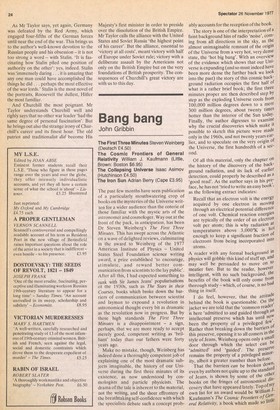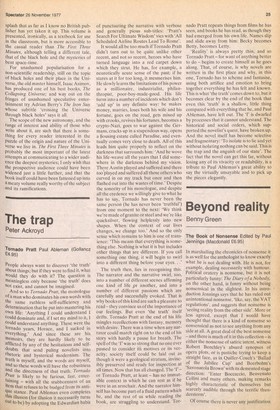Bang bang
John Gribbin
The First Three Minutes Steven Weinberg (Deutsch -£4.50) The Cosmic Frontiers of General Relativity William J. Kaufmann (Little, Brown: Boston $6.95) The Collapsing Universe Isaac Asimov (Hutchinson E4.50) The Iron Sun Adrian Berry (Cape E3.95) The past few months have seen publication of a particularly mouthwatering crop of books on the mysteries of the Universe written for a wider audience than the coterie of those familiar with the mystic arts of the astronomer and cosmologer. Way out at the front of the pack, in anticipation, has been Dr Steven Weinberg's The First Three Minutes. This has swept across the Atlantic on a wave of delighted reviews, culminating in the award to Weinberg of the 1977 American Institute of Physics — United States Steel Foundation science writing award, a prize established `to encourage, stimulate, and reward better communication from scientists to the lay public'. After all this, I had expected something to rank with Sir James Jeans' popularisations of the 1930s, such as The Stars in their Courses, books which broke down the barriers of communication between scientist and layman to expound a revolution in astronomical thought every bit as dramatic as the revolution now in progress. But by these high standards The First Three Minutes is a disappointment — a sign, perhaps, that we are more ready to accept merely good, competent writing as 'brilliant' today than our fathers were forty years ago.
Make no mistake, though, Weinberg has indeed done a thoroughly competent job of explaining one of the most dramatic subjects imaginable, the history of our Universe during the first three minutes of its existence, as now understood by cosmologists and particle physicists. The drama of the tale is inherent to the material, not the writing, and the sheer effrontery of the breathtaking self-confidence with which the specialists debate such a concept prob ably accounts for the reception of the book.
The story is one of the interpretation of a faint background hiss of radio 'noise', coming from all directions in the sky, as the almost unimaginable remnant of the origin of the Universe from a very hot, very dense state, the 'hot big bang'. With an overview of the evidence which shows that our Universe is expanding (and so must indeed have been more dense the further back we look into the past) the story of this cosmic background radiation occupies the first half of what is a rather brief book; the first three minutes proper are then described step by step as the exploding Universe cools from 100,000 million degrees down to a mere 300 million degrees, about twenty times hotter than the interior of the Sun today. Finally, the author digresses to examine why the crucial discoveries which make it possible to sketch this picture were made only in the 1960s, and not twenty years earlier, and to speculate on the very origin of the Universe, the first hundredth of a second.
Of all this material, only the chapter on the history of the discovery of the background radiation, and its lack of earlier detection, could properly be described as a 'good read'. As the author says in his pre,face, he has not 'tried to write an easy book, as the following extract indicates: Recall that an electron volt is the energY acquired by one electron in moving through an electrical potential difference of one volt. Chemical reaction energies are typically of the order of an electron volt per atom; this is why radiation at temperatures above 3,000°K is hot enough to keep a significant fraction of electrons from being incorporated int° atoms.
A reader with any formal background in physics will gobble this kind of stuff up, and may well be persuaded to move on to meatier fare. But to the reader, however intelligent, with no such backgroUnd, the benefits of the book will only come from thorough study — which, of course, is no bad thing in itself. I do feel, however, that the attitude behind the book is questionable. On the jacket we are told that the 'common reader is here `admitted to and guided through an intellectual preserve which has until nov; been the property of a privileged feW Rather than breaking down the barriers or this preserve, opening it to all comers in the style of Jeans, Weinberg opens only a small door through which the select can be 'admitted' and 'guided'. The preserve remains the property of a privileged min°r" ity, albeit a greater number than before.
of Jeans, is shown by some of the other books on the fringes of astronomical dtscovery that have appeared lately. Top of MY own list for an award would be William J. Kaufmann's The Cosmic Frontiers of general Relativity, a book which made so little splash that as far as I know no British publisher has yet taken it up. This volume is presented, ironically, as a textbook for use in the classroom, but is more accessible to the casual reader than The First Three Minutes, although telling a different tale, that of the black hole and the mysteries of bent space-time.
For unashamed popularisation for a non-scientific readership, still on the topic of black holes and their place in the Universe, the old master himself, Isaac Asimov, has produced one of his best books, The Collapsing Universe; and way out on the fringes of unashamed speculative entertainment try Adrian. Berry's The Iron Sun whose subtitle 'crossing the Universe through black holes' says it all.
The scope of the new astronomy, and the range of interest and ability of those who write about it, are such that there is something for every reader interested in the Puzzle of the origin and nature of the Universe we live in. The First Three Minutes is probably the most important of the latest attempts at communicating to a wider audience the deepest mysteries; I only wish that the prospective audience could have been Widened just a little further, and that the book itself could have been fattened up into a meaty volume really worthy of the subject and its ramifications.







































 Previous page
Previous page